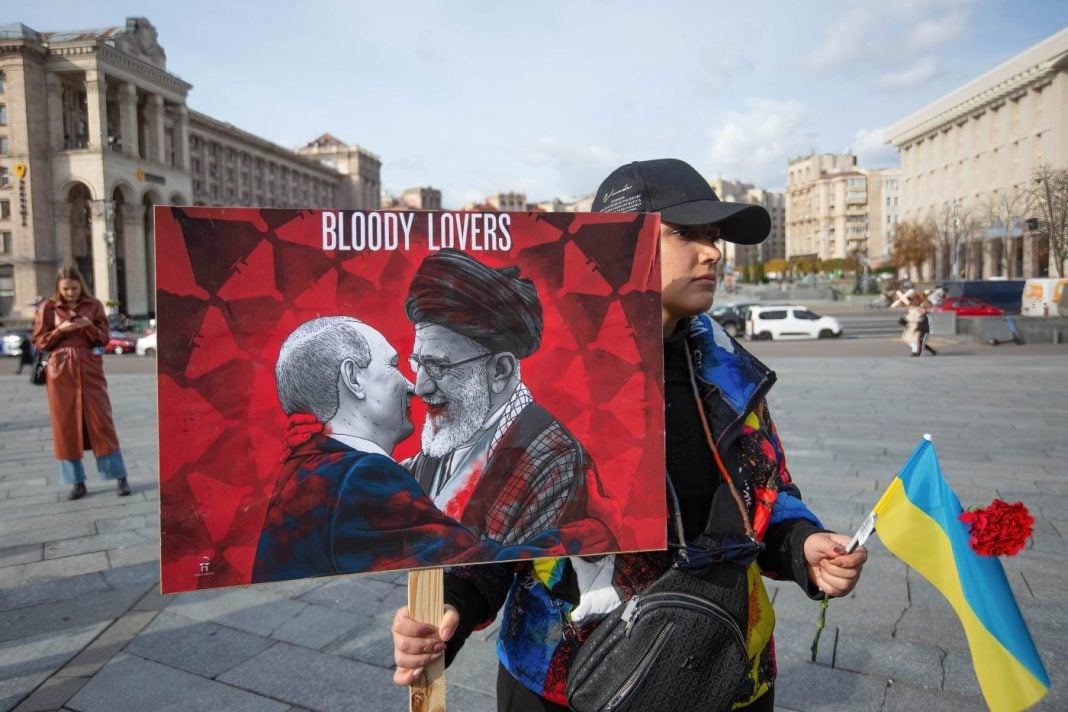Things have changed beyond recognition for the Kremlin’s bosses as their once-formidable global network suffers one defeat after another.
By Ben Dubow, for CEPA
Vladimir Putin’s vision of a multipolar world order seemed tantalizingly close to reality in August 2021. The chaotic American retreat from Afghanistan and swift collapse of the government in Kabul provided a stark contrast with Russian projection of power.
Russia’s seizure of Crimea and decisive intervention in the Syrian Civil War seemed to reflect a resolve that the West sorely lacked. Russia’s new global architecture would be underwritten by its military might and weaponry, offering autocrats an alternative to Western hegemony.
This was music to the mullahs. From the Iranian viewpoint, the partnership promised not just survival but supremacy — Russian S-300 air defense systems would shield its skies while Revolutionary Guards, armed with Russian weapons, would make Tehran kingmaker throughout the Middle East. And the Iranian arc of influence did indeed stretch from the shores of the Persian Gulf through Iraq, Syria, and Lebanon to the Mediterranean.
Three years later, that vision lies in ruins, buried beneath the rubble of Ukrainian cities and Iranian nuclear facilities. As the Iranian regime rocks to the attacks of Israeli and US jets that freely roam its skies, they have found their Russian armaments useless and their decades of partnership with Moscow good for little more than mealy-mouthed denunciations (as with Putin’s hollow offers of support on June 23).
This is a far cry from the days of military cooperation at the height of the Syrian Civil War. Russian airpower saved Bashar al-Assad’s regime, while Iranian proxies provided the ground forces. Together, they crushed the opposition and established a model for authoritarian cooperation that seemed unbeatable. By early 2022, Russian military advisors operated freely from Beirut to Baghdad, while Iranian forces used Syrian bases and Hezbollah to threaten Israel at will.
When America’s 20-year project of nation-building in Afghanistan collapsed in total failure later that year, Russian tabloids triumphantly declared that the West, its allies, and its kit were all little more than paper tigers. It was in this spirit that Russian troops entered Ukraine with three days of supplies, dress uniforms packed for victory parades, and extra space for imperial hubris.
No one had told the Ukrainians. Russia proved incapable of subduing a much smaller foe supplied with Western weapons, and slowly but surely things problems began to emerge the Kremlin’s global radar. Tajikistan pierced deep into the territory of Kyrgyzstan, a Russian treaty ally, and Russia responded with impotent calls for peace. Azerbaijan launched a lightning offensive against Russian-armed Armenia, another treaty ally, and again Moscow could muster no more than strongly worded statements. Armenia, recognizing the worthlessness of Russian protection, began openly discussing leaving the CSTO altogether.
If Azerbaijan’s victory was a warning, Assad’s fall in December was the confirmation. The Syrian regime that Russia had spent huge sums of money of dollars to preserve, collapsed in days when facing a ragtag rebel offensive. Russian forces, overstretched in Ukraine, simply evacuated. Years of investment, the lynchpin of Russian Middle Eastern strategy, abandoned without a fight. Moscow issued its usual denunciations and moved on.
Iran had been an early victim of Russia’s full-scale invasion: when global grain prices soared, Russia reneged a deal to supply 10 million tons of foodstuff, with the resulting hardship leading to the deadliest protests in the Islamic Republic’s history. Nonetheless, Iran sought to deepen its strategic ties with Russia, hoping that its importance to Russia’s global vision outweighed that of Armenia or Assad.
The past two weeks have delivered the final verdict on that choice. Israeli F-35s have operated over Iran with impunity. The integrated air defense network that Iran built with Russian and Chinese assistance — those S-300 batteries that were supposed to create an impenetrable shield — have proven useless. Not a single Israeli jet has been shot down. When American bombers struck Iran’s underground nuclear facilities yesterday, Iran failed so much as to engage the aircraft.
Whether that was a result of indecision from the decapitation of Iranian military leadership, the inadequacy of Russian- and Iranian-built air defense, or something even more profound, remains to be seen. But Russia’s response is now familiar to those who counted on its protection: warm appreciation for the arms and other help supplied to Russia for its imperial war, but only calls for de-escalation and a sympathetic smile when the loyal ally needs something in return.
The Russian-backed world order that seemed so inevitable in August 2021 has revealed itself as a chimera.
Russian weakness has allowed a cascade of collapse among its partners and allies, each failure reinforcing the next. Iran — perhaps the last true believer in Russian power — now faces the consequences of that faith.
Between the level of Israeli intelligence penetration into the Iranian security apparatus and the potential unwillingness of that apparatus to engage, Putin’s view from 2021 seems now exactly backwards: it’s his global vision that is failing.
By Ben Dubow, for CEPA
Ben Dubow is the co-founder of Omelas, which builds multilingual, multidomain AI for intelligence research and reporting. His research on Iranian politics and foreign affairs has appeared in RealClearPolitics, Democracy Digest, Voice of America, and Radio Farda. He speaks Persian, Arabic, and Russian.
Europe’s Edge is CEPA’s online journal covering critical topics on the foreign policy docket across Europe and North America. All opinions expressed on Europe’s Edge are those of the author alone and may not represent those of the institutions they represent or the Center for European Policy Analysis. CEPA maintains a strict intellectual independence policy across all its projects and publications.





